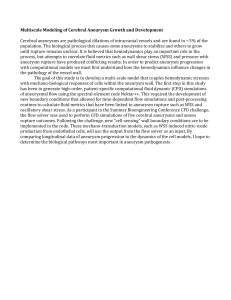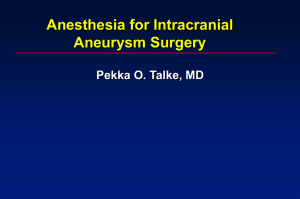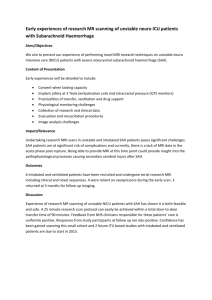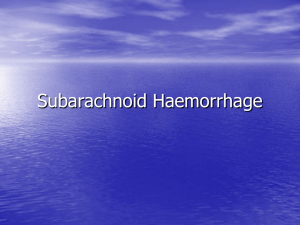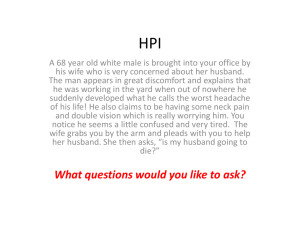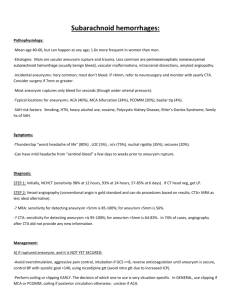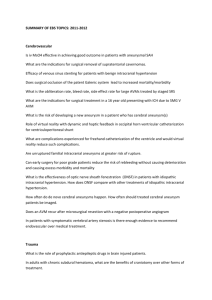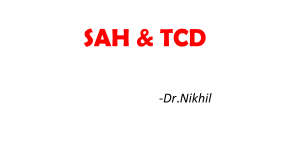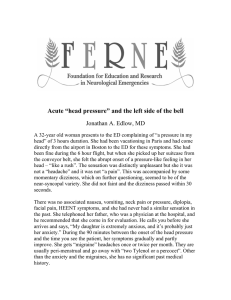Subarachnoid Hemorrhage and It*s Complications
advertisement
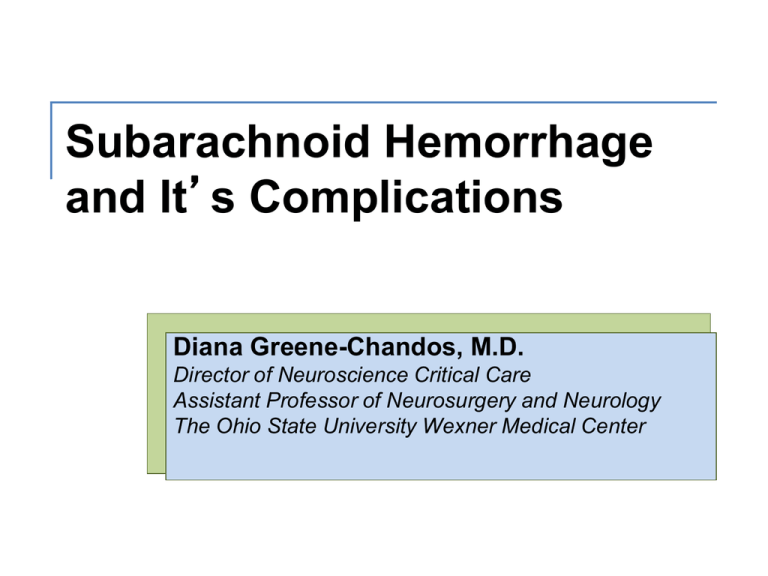
Subarachnoid Hemorrhage and It’s Complications Diana Greene-Chandos, M.D. Director of Neuroscience Critical Care Assistant Professor of Neurosurgery and Neurology The Ohio State University Wexner Medical Center Objectives Describe the underlying pathology and symptoms of subarachnoid and hemorrhagic stroke Identify risk factors associated with spontaneous intracerebral hemorrhage. Describe the factors associated with hematoma expansion and poor outcome. Understand the role and indications for surgical hematoma evacuation. Identify when additional imaging is needed after intracerebral hemorrhage. Define stroke and understand its natural history Discuss the risk factors and pathogenesis of vascular disease The Subarachnoid Space The interval between the arachnoid membrane and pia mater. More generous in the spine Or It’s a Great Name for a Band Bleeding in the Subarachnoid Space Trauma (most common etiology) Aneurysmal Benign perimesencephalic Traumatic SAH Traumatic SAH Tends to happen more commonly with moderate to severe head trauma Typically associated with other types of brain injury such as contusions, subdural hematomas and/or diffuse axonal injury Typically associated with additional body or head and neck trauma. Low risk of delayed ischemic deficits but can have cerebral salt wasting syndrome Aneurysmal SAH 5% of population Rupturing is more common in women overall and in men under the age of 40 Overall Aneurysmal SAH Prognosis Among 100 typical patients with a-SAH 33 will die before receiving medical care 20 will die or remain incapacitated from initial SAH 17 will deteriorate (50% recovering and 50% with severe neurological deficits) 30 will do well Cerebral Aneurysms Most common sites for cerebral aneurysms Other tidbits about aneurysms Multiple aneurysms present 14-24% of the time 7-20% of of pts with a ruptured aneurysm have a first or second degree relative with an aneurysm If you are a first degree relative of someone with a ruptured cerebral aneurysm risk of having an aneurysm is 4 times higher Screening should occur in people with 2 or more first degree relatives with cerebral aneurysms or with 1 relative and tobacco abuse history +/uncontrolled hypertension. Risks for cerebral aneurysm formation Hypertension Tobacco abuse Polycystic Kidney Disease Coarctation of the Aorta Fibromuscular Dysplasia Pseudoxanthoma Elasticum Marfan’s syndrome Risks for cerebral aneurysm rupture Surges in blood pressure Strenuous activity Size greater than 7mm The symptoms.. Sudden severe headache Usually occipital Nuchal pain also present Vomiting Decreased alertness Sentinel Hemorrhage 31% of patients have a sentinel headache 50% of patients with a sentinel hemorrhage are misdiagnosed by physicians. Focal Neurological Deficits with Cerebral Aneurysms Bitemporal Hemianopsia Basilar bifurcation Weber’s Syndrome Giant SCA Hemiparesis and Aphasia or Sensory Neglect Giant MCA Aneurysms Third Nerve Palsy (Pupil involved): Intracranial ICA PCOM SCA Diagnosis of Aneurysmal SAH Head CT is BEST…. Do not hesitate to do an LP if there is any doubt…collect Tube #1 and Tube #4 for cell count with differential Note: it may take up to 12 hours after onset of HA for xanthrochromia to develop if just color is being looked at Spectrophotometry will quantify the amount of hemoglobin and bilirubin and is independent of age of SAH. CT example of Aneurysmal SAH The Fisher Grade I.....No blood evident on CT II….Blood less than 1mm at maximal width on CT III….Blood greater than 1mm maximal width on CT IV….Any blood width with IVH or parenchymal extension The Hunt-Hess Grade I…..Asymptomatic or Minimal HA and slight nuchal rigidity II….Moderate to Severe HA, nuchal rigidity, no neurological deficit other than CN III….Drowsiness, confusion or mild focal deficit IV….Stupor, moderate to severe hemiparesis V….Deep coma with posturing You’ve confirmed SAH…now what? Admit to NCCU…no matter what. Keep the patient calm, quiet and pain free. SBP must be kept below 160 systolically Minimize procedures Best drugs for bp Labetolol 10-20mg iv q 15 min prn Hydralazine 10 mg iv q 20 min prn If 3 doses required within 2 hours start Nicardipine drip at 5mg/hr and titrate to goal bp Confirmation of an Aneurysm • CT angiography will help the angiographer know where to focus (but avoid if there is clear SAH and significant renal dysfunction in a patient NOT on HD) • Cerebral Angiography is the gold standard. • If the aneurysm is able to be coiled intravascularly, it will be done at the time of the angiogram. Example of CT with Corresponding Angiography The coiling process with microcatheter What if it cannot be coiled? The Titanium Clip! The Pipeline Stent Back to the NCCU…what’s next? Cerebral Edema Phase Days 3-5 post SAH Utilize Hypertonic (3%) Saline to decrease Why not Mannitol? The Vasospasm Window Days 4-14 Creates Delayed Ischemic Deficits Responsible for worsening outcomes in 1/3 patients Monitoring Vasospasm Clinical Symptoms (HA, confusion, focal deficits) Clinical Signs (increasing bp, increasing urinary output, dropping sodium levels) Studies: Transcranial Doppler CT Angiography (95% negative predictive value) CT Perfusion Cerebral Angiography EEG with Compressed Spectral Analysis Preventing (?) Vasospam Nimodipine 60mg p.o. q 4 hrs for 21 days Euvolemia Normal Magnesium level (2.0 or greater) Avoid hypotension Treat abnormal LDL with statins Treating Vasospasm (Medical) • HHH therapy (Hypervolemia, Hypertension, and Hypoviscosity) • Goal Intake and Output net for every 24 hours should be 1-500cc positive • Goal SBP 160-220 (may use neosynephrine once a clear euvolemia to slightly hypervolemic state is reached to achieve) • Goal Hemoglobin is 10 Treating Vasospasm (Surgical) Intra-arterial injection of Calcium Channel Blockers (here we use verapamil) at the site of vasospasm Direct Angioplasty (high risk) What about AEDs? Use in all aneurysmal SAH until aneurysm secure. If a seizure has occurred, keep AED for 4 weeks If a seizure has occurred and an intraparenchymal hemorrhage was also present, consider longer treatment than 4 weeks. Leviteracetam or Phenytoin What About Hydrocephalus? Common EVD should be placed in those with radiographic HCP and high grade SAH Delayed Hydrocephalus (under normal pressure) can occurred months or even years after SAH due to scarring What if there is an SAH and a Negative Angiogram? Re-review history….? Occult trauma Thrombosis of ruptured aneurysm Difficult to visualize small aneurysm Spinal AVM Cerebral Venous Thrombosis Vasculitis Benign Perimesencephalic Negative-Angiogram SAH Words to Never Forget….. Remember: The Onus is on us to prove that there is no aneurysm. So if one is not seen on the first angiogram and there is no other etiology for the hemorrhage found, repeat the angiogram in 7 days. Cardiac Effects Catecholamine induced subendocardial myonecrosis Temporary or permanent reduction in EF Arrythmias (typically tachyarrhythmia unless increased ICP, then bradyarrhythmias) Flash pulmonary edema Monitoring and Care Ideally in a high volume center Institutions with a dedicated Neuro-ICU with Neuroscience Nurses are preferred and shown to improve outcomes My reasons to prevent a Stroke Thank you for completing this module Questions? Diana.Greene-Chandos@osumc.edu Survey We would appreciate your feedback on this module. Click on the button below to complete a brief survey. Your responses and comments will be shared with the module’s author, the LSI EdTech team, and LSI curriculum leaders. We will use your feedback to improve future versions of the module. The survey is both optional and anonymous and should take less than 5 minutes to complete. Survey

